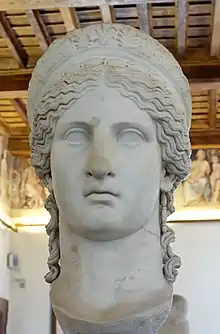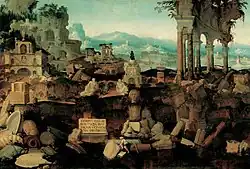Juno Ludovisi
The Juno Ludovisi (also called Hera Ludovisi) is a colossal Roman marble head of the 1st century CE from an acrolithic statue of an idealized and youthful[3] Antonia Minor as the goddess Juno.[4] Added to the Ludovisi collection formed by Cardinal Ludovico Ludovisi, it is now in the Palazzo Altemps, Museo Nazionale Romano, Rome.
| Juno Ludovisi | |
|---|---|
 | |
| Created | 1st century A.D. |
| Place | Palazzo Altemps |
| Present location | Rome |
| Identification | inv. 8631 |

Casts of it are in the University of Cambridge Classics Department Casts Gallery, UK;[5] Bryn Mawr College, Pennsylvania, USA;[6] the Goethehaus in Weimar, Germany; George Mason University, Johnson Center, Fairfax, USA;[7] the University of Helsinki, Department of Art History, Finland;[8] and the University of Tartu Art Museum, Estonia.[9]
Description
The sculpture was made of Parian marble, and is generally considered to be a posthumous and deified portrait of Antonia Minor, mother of Claudius.[10][11]
The bust was probably found in Rome, and prior to joining the Ludovisi Collection, was owned by Cardinal Federico Cesi.[12]
There is debate over whether in addition to Antonia Minor the bust could represent Livia.[13]
Legacy and Popular Culture
As early as 1536, the presence of the sculpture was known to the general public prior to the ownership by Ludovisi.[1] The painting, Landscape with Roman Ruins by painter Herman Posthumus depicts the bust at forefront, surrounded by Egyptian and Roman sculpture fragments with a quote from Ovid's Metamorphoses: "TEMPVS EDAX RERVM TVQVE INVIDIOSA VESTVSTAS O[MN]IA DESTRVITIS" (Translated: Oh, most voracious time, and you, envious Age, you destroy everything).[1]
The sculpture is known to have been greatly admired by Goethe, who bought a cast of it, soon after seeing it in Rome.[14]
The American-British novelist Henry James mentions the Ludovisi Juno several times including in his first long form novel Roderick Hudson. He described it in its surround as follows..."One warm, still day, late in the Roman autumn, our two young men were seated beneath one of the high-stemmed pines of the Villa Ludovisi. They had been spending an hour in the mouldy little garden-house where the colossal mask of the famous Juno looks out with blank eyes from that dusky corner which must seem to her the last possible stage of a lapse from Olympus"...[15]
Notes
- Curran, Brian A. (2018-07-24), Holleran, Claire; Claridge, Amanda (eds.), "The Renaissance: The "Discovery" of Ancient Rome", A Companion to the City of Rome, Chichester, UK: John Wiley & Sons, Ltd, pp. 643–671, doi:10.1002/9781118300664.ch32, ISBN 978-1-118-30066-4, S2CID 194866882, retrieved 2023-08-07
- "Herman Posthumus". Liechtenstein. The Princely Collections, Vaduz–Vienna. Retrieved 2023-08-07.
- "The coiffure of Antonia's youth is characterized by a central part and round, braided hairknot" (K. Patricia Erhart, "A Portrait of Antonia Minor in the Fogg Art Museum and Its Iconographical Tradition", American Journal of Archaeology 82.2 (Spring 1978:193-212) (online abstract).
- R. Tölle-Kasterbein, "Juno Ludovisi: Hera oder Antonia Minor?" Mitteilungen dI (A), 89 1974.
- Museum of Classical Archaeology
- Susan Wood, "Goddess or woman?"
- Klassikstiftung Weimar, Goethes Wohnhaus,
- Virpi Huhtala, "Taidetta kirjastossa" [Art in the Library],
- University of Tartu Art Museum
- Tölle-Kastenbein, Renate. "Juno Ludovisi: Hera oder Antonia Minor?". Mitteilungen des Deutschen Archàologischen Instituts. Atenische Abteilung. 89 (1974): 241–253.
- Watkins, Thomas H.; Kokkinos, Nikos (1994). "Antonia Augusta: Portrait of a Great Roman Lady". The Classical World. 88 (2): 144. doi:10.2307/4351669. ISSN 0009-8418. JSTOR 4351669.
- Giustozzi 2005 - cited in Bibliography p.140
- Jongkees, Jan Hendrik (1942). "De Hera Ludovisi en Livia". Bulletin Antieke Beschaving. 17: 13–16.
- "Hera Ludovisi". ringlingdocents.org. Retrieved 2023-08-07.
- "The Novels and Tales of Henry James/Volume 1/Roderick Hudson/Chapter 5 - Wikisource, the free online library".
Bibliography
- Nunzio Giustozzi,, "Una Giunone adorata", in Adriano La Regina (a cura di), Museo nazionale romano, Electa, Milano 2005, ISBN 88-370-37430, p.140.
